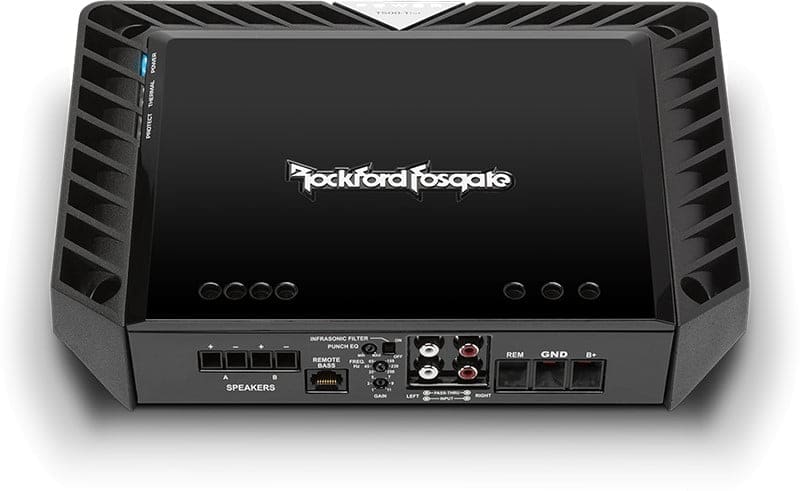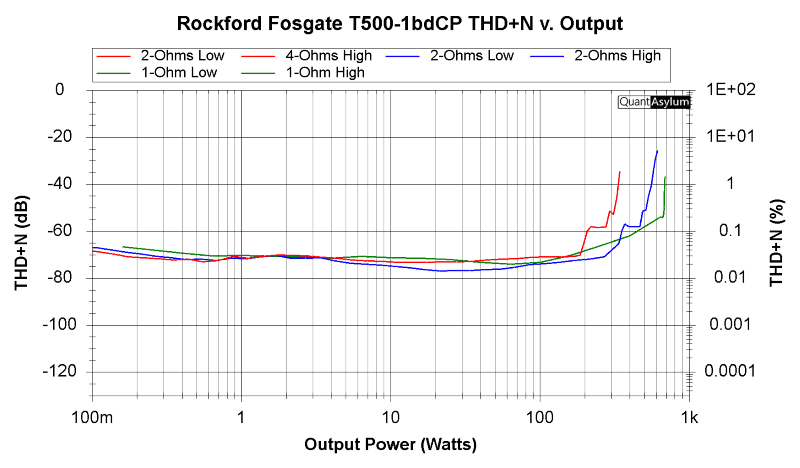In January of 2024, we had the privilege of reviewing the Rockford Fosgate T500-1bdCP amplifier. Based on our experiences with amplifiers from the company, it was no surprise that the amp sounded amazing, was impressively efficient, and exceeded all of its power ratings. The latter is the focus of the re-test. We’ve recently upgraded the power supplies in the BestCarAudio.com Test Drive Review lab. As such, we can supply the subjects with a full 14.4 volts to provide you with measurement numbers that comply with the ANSI/CTA-2006-D standard. So, let’s have another quick look at the highlights of this impressive amplifier, then dig into some new power measurements and efficiency calculations.
Rockford Fosgate T500-1bdCP Features
Here’s what you need to know without going into the same detail as the original Rockford Fosgate T500-1bdCP Review. Firstly, this is a dedicated subwoofer amplifier. It has an as-measured -3dB frequency response of 4.4 to 230 hertz. That bottom-end extension is pretty impressive.
The amp is rated to produce 300 watts of power when connected to a four-ohm load and 500 watts to two- and one-ohm loads. There are amplifiers that produce more power for less money. However, this amp also sounds fantastic. We measured an impressive 0.0213% THD+N at four ohms. Like many others, the amp didn’t fall on its face at lower impedances. Distortion numbers dropped to 0.0226% at two ohms and a still impressive 0.0294% when driving a one-ohm load. These measurements were taken at the ANSI/CTA-2006-D standard of 1-watt output. However, the graph you’ll see below shows the amp remains composed across the entire power output range.
Feature-wise, the amp includes an adjustable -24dB/octave low-pass filter that can be set anywhere between 35 and 250 hertz. It also has a selectable infrasonic filter fixed at 28 hertz with a -12dB/octave second-order slope. Lastly, and as you’d expect, the amp includes the Punch EQ control. Your installer can use this to dial in up to 18dB of boost at 45 hertz to add some extra slam to your audio system. The Punch EQ filter is nice and narrow, so turning it up doesn’t make your midbass sound terrible.

An essential feature of the amplifier that many overlook is its cast-aluminum heatsink. Unlike extruded designs, cast heatsinks offer significantly more surface area. When combined with expertly designed efficient circuitry, your amplifier will play longer without overheating. We tested the T500-1bdCP for over an hour at full power into a two-ohm load, and it never shut down. By comparison, we’ve had several amps go into thermal protection in under four minutes. Cast heatsinks are significantly more expensive to manufacture, but if you want to know why people are still using three-decade-old Rockford Fosgate gear, this is one of the reasons why. Think of it like comparing a Zippo lighter to a plastic BIC lighter. Both might light the candles on a cake, but only one is designed to last for your entire life.

Re-Testing the T500-1bdCP
The ANSI/CTA-2006-D Testing and Measurement Methods for In-Vehicle Audio Amplifiers standard has changed a bit from previous versions. Specifically related to continuous power testing, the sensitivity control should now be set to its minimum sensitivity setting. Looking at it from the opposite perspective, the amp should be set to make its maximum power from the highest amount of input signal. For the T500-1bdCP, that would be five volts, according to the owner’s manual. We’ll discuss why this matters in another article.
The next clarification is that the amp must be able to produce this power level for at least 15 seconds. Previous versions of the CTA-2006 standard required the amp to be capable of making this rated output for one minute. While the technician side of me thinks the longer the test, the better, one minute at full power is a long time. Many low-quality amplifiers would be close to overheating. Our testing runs for a little over 15 seconds, which makes it fully compliant with ANSI/CTA-2006-D.
Lastly is voltage. All the standards have stated that the primary continuous power rating be measured with the amplifier supplied with 14.4 volts with a tolerance of +0% to -5%. We fine-tune the adjustment on our new power supplies to be within a few hundredths of a volt of 14.4, which significantly exceeds the 13.68-volt minimum. When it comes to making power, more voltage is always better.
We set the T500-1bdCP up on the bench, turned the sensitivity and Punch EQ all the way, turned the infrasonic filter off, and set the crossover to its highest frequency. We started with the continuous four-ohm power test first. In the original review, we measured 334.9 watts at 1% THD+N with 14.47 volts. With the sensitivity control lower and, thus, less noise in the signal, we saw 339.1 watts at precisely 14.4 volts.
Next, we added our second bank of four-ohm load resistors to provide the amp with a two-ohm load. The original test showed 544.4 watts from 14.12 volts. In the new test at exactly 14.4 volts, the amp produced 583.4 watts. The observed additional 29.3 watts from 0.28 volts is impressive.
Finally, we get to the 1-ohm testing. The original test saw the amp produce 697 watts when fed with 13.9 volts. Now, with an extra half-volt on tap, we measured 766.2 watts. Ignoring the extra 69.2 watts, this means the amplifier produces 53.2% more power into a one-ohm load than it’s rated for. If you’ve ever wondered why the Power Series amplifiers seem to jam harder than they should, this is why.
With this re-test, we are going to introduce a new way of presenting the power versus THD+N graph. Rather than having them in separate graphs, we’ve taken the time to overlay all the traces into a single chart. You can see how clean the amp is right from 100 milliwatts up to where it reaches clipping. The traces are color-coded to make things easy to compare. The red trace is the four-ohm measurement, the green shows the two-ohm performance, and the blue trace is the one-ohm information.
Interestingly, the amp isn’t plagued by noise at low power levels. This is another topic we will cover in a future article.
Increased Efficiency
A secondary benefit of providing an amplifier with more voltage is, in this case, an improvement in efficiency. Based on the original power numbers and associated measurements, the amp was 86% at four ohms, 83% efficient at two ohms, and 63% efficient when driving a one-ohm load. Our new measurements show that these numbers have improved to 87%, 84%, and 74%, respectively. You can see these calculations in the power measurement chart above.
Improved efficiency is a big deal. First, it means the amp won’t heat up as quickly, translating to more playtime. Further, and what matters in the case of your vehicle, it means you get more output power from the limited power available from the charging system.
An Amazing Subwoofer Amplifier
The T500-1bdCP’s performance already blew us away. Having the chance to repeat the power tests with the proper supply voltage shows the value that Rockford Fosgate’s product presents. They could easily rate the amp capable of producing 750 watts into a one-ohm load. Even though they don’t, you now know it can.
If you are shopping for a subwoofer amp that sounds amazing and makes lots of clean power, drop by a local authorized Rockford Fosgate retailer and ask about the T500-1bdCP. You can find a dealer near you using the locator tool on their website. As always, follow the gang from Tempe on Facebook, Instagram, and YouTube to stay up to date with all their car, marine, powersport, and motorcycle audio product releases.
This article is written and produced by the team at www.BestCarAudio.com. Reproduction or use of any kind is prohibited without the express written permission of 1sixty8 media.




Leave a Reply